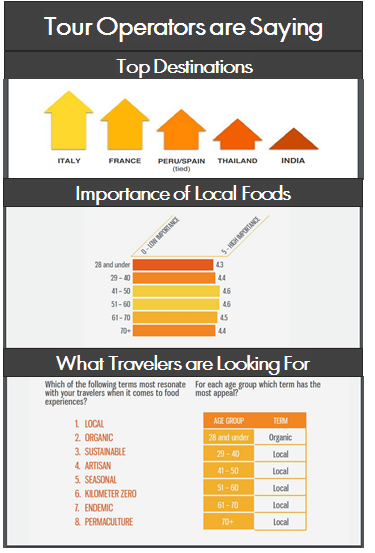Tour Operators Innovate with Food and Adventure Tourism (Infographic)
By David Eddy on Mar 8, 2016 7:00:00 AM

One travel industry trend that holds particular promise for growth is experiential travel. To an increasing extent, people want to return from their destinations with a sense  of having authentically experienced that part of the world.
of having authentically experienced that part of the world.
Whether it’s meeting the people who live there, hiking and biking to intermingle with flora and fauna, or eating local foods, travelers really want to feel they really know about where they’ve been.
The manner in which a travel agency or tour company is able to address this trend will allow them stand out from the competition and increase sales. Last month the Adventure Travel Trade Association released a Tour Operator survey on Food and Adventure Tourism which showed how this niche is ripe for innovation and growth.
Food and Adventure Tourism Infographics
A key attribute of this type of travel is that activity isn’t the purpose of the experience: instead, the activity should trigger the experience. In other words, people aren’t going to travel to Italy specifically to sample various kinds of pasta, but sampling local delicacies in Tuscany can be the catalyst for an experience that transforms the entire trip. It pulls them out of the bus, puts them into a unique, but comfortable, environment and provides a common topic of conversation with people they’ve never met before.
In today’s travel industry, consumers - particularly tour customers, are moving away from the traditional travel mindset of completing lists of sightseeing “musts”, and realizing there can be subtle experiences with more delight than the highlights in the guidebook.
As can be seen in the infographic on the right, the most popular countries for food tourism are a mix of the familiar and the new: seeing Italy and France as the top destinations is not unexpected; but a tie between Spain and Peru for third and fourth is something of a surprise.
A revealing insight is captured in what travelers are looking for in a food experience. Given a choice of eight food terms, all but the youngest age group chose “local”. The other seven choices reflected specific traveler preferences: seasonal, artisan, sustainable, etc. “Local”, on the other hand, implies the travelers are suspending their own preferences in favor of being open to undefined local cuisine possibilities.
The infographic on the left is thought provoking for how innovation in this experiential travel area – combined with effective marketing - can create growth opportunities for a tour company, or a travel agency acting as a distributor of their products.
The top graph s hows that 51% of tour itineraries incorporating food experiences were “somewhat” or “definitely” more popular than those that did not. Yet the bottom graph makes it clear that food experiences are “incidental” – rather than “central” in tour product marketing.
hows that 51% of tour itineraries incorporating food experiences were “somewhat” or “definitely” more popular than those that did not. Yet the bottom graph makes it clear that food experiences are “incidental” – rather than “central” in tour product marketing.
In other words, 76% of the marketing of tour products is ignoring a feature popular with more than 50% of customer: food experiences!
The lack of coordination between tour marketing and food tourism popularity extends to the tour product itself.
As the middle graph in this infographic makes clear, 71% of tour operator trips have a moderate or high focus on food experiences – yet 76% of tour marketing gives only incidental attention to that fact!
There’s no question food experiences are an important part of tour customer satisfaction – just as its clear tour operators are making food experiences a big part of tour itineraries. For some reason, marketing is failing to take advantage of these two strengths.
Tour operators and travel agencies that take a clear message about their food experience innovations to the marketplace have excellent prospects for attracting new customers and taking sales away from competitors. This opportunity should not be missed.
- travel technology (58)
- Travel Industry (49)
- travel agency (31)
- travel erp (31)
- travel trends (28)
- travel booking system (23)
- TINA (21)
- travel company (19)
- Tour Operator (18)
- Product updates (17)
- Travel Management Company (17)
- AIDA (15)
- TBS (15)
- dcs plus news (14)
- tour operator solution (14)
- travel website (14)
- travel erp system (13)
- Business Travel (12)
- Mobile App (12)
- Travel App (12)
- mid back office solution (12)
- trends (12)
- Industry Events (11)
- Mobile Technology (11)
- TMC (11)
- travel agents (11)
- erp (10)
- erp system (10)
- Corporate Travel (9)
- Tour Operators (9)
- Travel booking engines (9)
- dcs plus (9)
- online travel agency (9)
- travel agent (9)
- Mobile Bookings (8)
- travel (8)
- travel agencies (8)
- 2017 (7)
- Mobile Travel (7)
- travel business (7)
- travel software (7)
- Digital Technology (6)
- Insider (6)
- Millennials (6)
- Online booking systems (6)
- Travel Management Companies (6)
- process automation (6)
- travel companies (6)
- Big Data (5)
- Business Traveler (5)
- Partners interviews (5)
- Tour Operator Software (5)
- customer retention (5)
- travel agency technology (5)
- Booking engines (4)
- CSBT (4)
- Mobile Device (4)
- OTAs (4)
- Static databases (4)
- Tour Companies (4)
- Travel Policy (4)
- Travel booking systems (4)
- Travel suppliers (4)
- back office automation (4)
- millennial travelers (4)
- online travel (4)
- responsive travel website (4)
- technology (4)
- travel website conversion (4)
- 2016 (3)
- Content mapping (3)
- Databases (3)
- Demographics (3)
- Food and Adventure Tourism (3)
- Mobile Apps (3)
- Mobile travel apps (3)
- Travel Distribution Channels (3)
- Travel Management Software (3)
- Travel customers (3)
- Travel history (3)
- anniversary (3)
- automated processes (3)
- content matching (3)
- global travel industry (3)
- social media (3)
- travel agency workflow (3)
- travel back office (3)
- travel marketing (3)
- travel process automation (3)
- Advanced Booking Systems (2)
- B2B Travel Resellers (2)
- Bleisure (2)
- Branding (2)
- Business Process Automation (2)
- Business Travelers (2)
- Customer engagement (2)
- Financial Reporting (2)
- Food Tourism (2)
- Inbound Marketing (2)
- Infographic (2)
- Leisure Travel (2)
- Saas (2)
- Templates (2)
- Travel Costs (2)
- Travel bookings (2)
- Travel start-up (2)
- Travel website abandonment (2)
- WTM 2016 (2)
- abandoned travel bookings (2)
- corporate self booking tool (2)
- engagement marketing (2)
- internet booking engine (2)
- millennial traveler (2)
- new travel company (2)
- office (2)
- online reputation management (2)
- online travel reviews (2)
- reporting (2)
- software (2)
- start-up tips (2)
- travel agency management (2)
- travel agency website (2)
- travel experience (2)
- travel mobile app (2)
- travel packages (2)
- travel reservation system (2)
- travel system (2)
- travelers (2)
- web-based travel erp (2)
- 2020 (1)
- 360 Customer View (1)
- Advanced Accommodation Contract Management (1)
- Adventure travelers (1)
- Apps (1)
- B2B Reseller (1)
- B2B Resellers (1)
- B2C (1)
- BI Reporting (1)
- Budget traveler (1)
- Cancellations (1)
- Chat (1)
- Chinese millennial (1)
- Cloud (1)
- Cognitive computing (1)
- Comparison shopping (1)
- Conference (1)
- Contact matching (1)
- Content (1)
- Cruise (1)
- Culinary traveler (1)
- Customer relations (1)
- Digital Innovation (1)
- Digital Natives (1)
- Documents (1)
- Emerging market travelers (1)
- Emerging markets (1)
- Errors (1)
- Experimental travel (1)
- Financial Dashboard (1)
- Import rates (1)
- Instant messaging (1)
- Integrate with Accounting Software (1)
- Internet (1)
- Luxury traveler (1)
- Mobile Transaction (1)
- Mobile payments (1)
- NDC distribution (1)
- Operational Reporting (1)
- Reseller networks (1)
- Resellers (1)
- Response (1)
- Subagents Network (1)
- TINA Academy (1)
- TTE (1)
- Travel Reseller Network (1)
- Travel Revenue Management (1)
- Travel booking problems (1)
- Travel finance reporting (1)
- Travel stats (1)
- WTM (1)
- abandonment (1)
- accomodations (1)
- advanced reporting (1)
- airline direct connect technology (1)
- ancillary services (1)
- cloud computing (1)
- collection (1)
- collection challenges (1)
- common data model (1)
- conversion rates (1)
- cost control (1)
- credo ventures capital invests in dcs plus (1)
- customer reviews (1)
- data analysis (1)
- dcs plus credo investment (1)
- dcs plus credo ventures (1)
- deloitte technology fast 500 EMEA (1)
- digital transformation (1)
- e-invoicing KSA (1)
- email marketing (1)
- email marketing for OTAs (1)
- erp e-invoicing (1)
- lost travel bookings (1)
- modern travel agencies (1)
- networks (1)
- new features (1)
- offers (1)
- online customer review (1)
- online reputation (1)
- online travel agencies (1)
- risk management (1)
- sales (1)
- senior travelers (1)
- shopping baskets (1)
- shopping carts (1)
- social network (1)
- standardized processes (1)
- static content (1)
- travel SaaS (1)
- travel account services (1)
- travel agency customers (1)
- travel agency profitability (1)
- travel analytics (1)
- travel blog (1)
- travel planning (1)
- travel reviews (1)
- travel shopping carts (1)
- travel software for agencies (1)
- travel software system (1)
- travel technology europe (1)
- travlist smart mobile app (1)
- trend (1)
- trusted adviser (1)
- trusted advisor (1)
- upsell functionality (1)
- vouchers (1)
- website traffic (1)
- zatca (1)
Subscribe by email
You May Also Like
These Related Stories

Why Tour Operators Should Target Adventure Travelers

Innovative Tour Operator Software drives Sales & Profits (does yours?)


Comments (1)